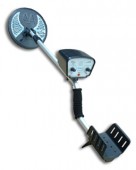 Loading... Please wait...
Loading... Please wait...metal detector for sales
-
US$142.99
-
US$98.99
-
US$74.99
-
US$98.00
-
US$49.99
- Home
- What are Underground Metal Detectors?
What are Underground Metal Detectors?
Posted on 21st Jun 2016 @ 10:27 AM
Bleep bleep! Bleep bleep! Is there anything more exciting than discovering treasure? Millions of people all around the world have fun using metal detectors to uncover valuable relics buried underground. Metal detectors are devices used to find hidden metallic items. These items range from old coins to gold nuggets and metal trinkets, and they are commonly found at beaches and historic sites. Let's learn more about metal detectors!
A metal detector is an electronic instrument which detects the presence of metal nearby. Metal detectors are useful for finding metal inclusions hidden within objects, or metal objects buried underground. They often consist of a handheld unit with a sensor probe which can be swept over the ground or other objects. If the sensor comes near a piece of metal this is indicated by a changing tone in earphones, or a needle moving on an indicator. Usually the device gives some indication of distance; the closer the metal is, the higher the tone in the earphone or the higher the needle goes.
This underground metal detector has the ability to explore metal, gold, bomb and so on underground. It is especially suitable for checking metal in food, fuel, and luggage, detecting underground pipes, mining and archeological digs. It is easy to operate and adopt the intellectualized operation system. Besides it owns the strong ability to penetrate the earth, stone, chinaware or other plastic and find the metal exactly. And the detecting distance can up to 1.5m.
For beginners, when you get an underground metal detector, you can follow the steps blow:
First step, be prepared. Many rumors and legends about underground treasure caches, or hoards, are based on some factual details. Throughout history, people have buried their valuables out of greed or in fear of advancing armies and other marauders, hoping to someday return and reclaim their treasure. Even today, this practice is not uncommon. Before you start hunting treasure, do as much research as possible beforehand. Look for any clues that may have been written down or passed down verbally from generation to generation. Keep a record of even small details; they may come in handy later.
Second step, determine how deep the treasure is buried. Based on your research, how far down the treasure is located. Frequently, individuals bury treasure far beneath the earth in large containers. Some of the largest hoards recovered to date have been found using deep penetrating metal detectors.
Third step, move the detector around side-to-side and front-to-back to really narrow down the scope. It is important for the investor to really narrow down where the treasure is before deciding to dig. Not knowing precisely where the item is can make the digging process a whole lot longer. To narrow down the area, you should move the detector around side-to-side and front-to-back until he has a good idea of precisely where the object is.
Are you attracted by the underground metal detector mentioned above. Why not buy one now?







